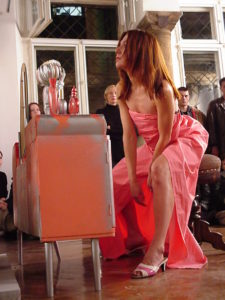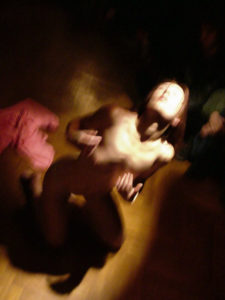So I discovered that direct action has value only on condition that one becomes engaged entirely, here and now. The object used in direct action is somehow the extension of the human being, his partner and not an alien supplement. A kind of intimate tie occurs between the doer and the object. Division into an object and a subject loses its sense and meaning. The imagination is powered in my body and carries on a love dialogue with the world – people, animals, objects.

My dialogue with Fire had a very erotic meaning. The etymology of the word eroticism is very old, as old as our Mediterranean culture. Who nowadays recollects the myth of Eros and Psyche ? Who is eager to do some effort in order to understand it? Our civilization builds new pop-mythologies. It is sad that nowadays almost all is considered in the categories of functionalism and commercialism, and also women’s eroticism is predominantly associated with sexual act and pornography. If one removes the burden of functionalism and utility from it, it may reveal a new, multidimensional and colorful face.
►Justyna Janiszewska-Krukowska, Body and Object. Key Discoveries in the Process of Work with Body and Object’, Contemporary Indian Theatre. Theatricality and Artistic Crossovers’, Jaipur, New Delhi: Rawat Publications 2017, 103-110, Editors: Ravi Chaturvedi & Tapati Gupta.
Justyna Jan-Krukowska in “Lady’s Dressing Table”, Entropia Gallery,Wroclaw 2000 ✴︎ Photograph by Kamil Zaremba.
Justyna Janiszewska-Krukowska’s experience’s in the ‘Women’s Rituals’ (1995-1999) project, under the guidance of Richard Nieoczym adds an interesting dimension to what I have called the metaphysics of theatre. Justyna discovers from close communion with nature, the air, earth, fire and water, her inner self, a unitary self of body, mind and object. The ability to concentrate, to stretch oneself beyond the limits of a physical orientation, to transcend the gross confines of the body no doubt is an important steeping stone to theatrical performance. The actor is both herself, and not herself, the realization that this is me and this is not me, yet this is not not me.The actor gets into and is initiated into the liminal space. As Schechner puts it, ‘The feeling of ‘this is me’ and the difference between this feeling of ‘this is not me’ that a child evolves, the actor in performance discovers an in-between on the stage which is ‘not me’ but also ‘not not me’.✴︎A complex mapping on the self and body, sexuality and cognition vis-a-vis the world and objects, which may be achieved in sensitized performance.
Justyna’s experiments in finding her theatrical self aligns with the Stanislavskian way, and the Brechtian way of self exploration, and lends to consciousness an exciting trajectory, negotiating another route to a deeper understanding which may be communicated to the spectator’s consciousness too.
► Tapati Gupta, ‘Contemporary Indian Theatre. Theatricality and Artistic Crossovers’, Jaipur, New Delhi: Rawat Publications 2017, 4-5.
✴︎Richard Schechner, Over, Under and Around: Essays on Performance and Culture, New Delhi, Calcutta: Seagull Books, 2004, 172.

Justyna Jan-Krukowska in “Lady’s Dressing Table”, Entropia Gallery, Wroclaw 2000✴︎ Photograph by Kamil Zaremba
Justyna Jan-Krukowska in “Lady’s Dressing Table”, Entropia Gallery, Wroclaw 2000✴︎ Photograph by Kamil Zaremba.

